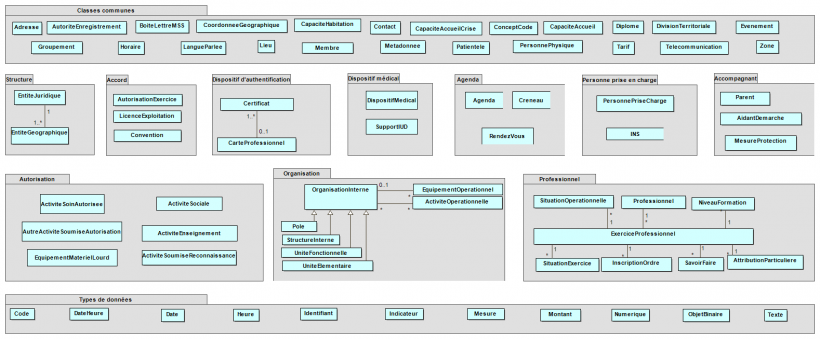Health objects model and nomenclatures (MOS-NOS)
Health objects model and nomenclatures allows to design interoperable eHealth services with a technology-agnostic method

Health objects model and nomenclatures, and method: the key to interoperability
As part of the drive to harmonise systems for exchanging data, which is a pre-condition for desegregating the health and social care sector and coordinating healthcare more effectively, the health objects model (MOS) and the associated nomenclatures (NOS) (in French) provide a core vocabulary.
Used in the method for elaborating functional specifications of exchange, this vocabulary is an essential component of the Interoperability Framework for Health Information Systems (CI-SIS), which is designed to enhance the semantic interoperability of interconnected information systems.
MOS and NOS are part of the drive launched by the Agence du Numérique en Santé to achieve its primary goal, namely to create conditions conducive to the development and adoption of eHealth tools and facilities.
Latest news
|
|
Latest news from the MOS / NOS team |
|---|---|
|
September 2020 |
Find out about the latest ‘implementation’ parts involving the re-use of MOS components in a specific context or application, such as the French National eHealth ID (INS). - Core components part of the agenda and medical facilities - Tracing part of implementation |
Indicators
Indicators as of october 2021 recording the number of attributes, classes and parts present in the two sections of the MOS: core components and the implementation of the core components.
| Monthly indicators | |||
|---|---|---|---|
|
core components |
557 |
68 |
10 |
|
implemented |
143 |
12 |
3 |
Health objects model
The MOS is a collection of concepts described homogeneously and neutrally in terms of technologies. It offers a common and pooled description of the information processed and exchanged in the information systems. The overall consistency of the MOS is founded on the definition and description of its UML (Unified Modelling Language) concepts.
Certain MOS concepts can be coded. They are associated with the nomenclatures of health objects (NOS), i.e. lists of codes/labels.
A core vocabulary
The MOS and NOS constitute a library of semantic components. This library centralises definitions, names, structures and codings of the information. This core French vocabulary affords stakeholders the same understanding of the concept being manipulated, regardless of the system from which it originates.
Diagram of UML class
The representation of MOS objects in a UML (Unified Modelling Language) class diagram helps to ensure their consistency and neutrality in relation to existing standards. This entails some UML knowledge for MOS readers who are not experts in analysing information systems. One of the other objectives of the MOS is to afford a literal description of each object in French that is accessible to everyone.

International standards
Each MOS concept is equated with other concepts that are part of international initiatives or standards:
- HL7
- Fast Healthcare Interoperability Resources (FHIR), HL7 v2.x and v3;
- Semantic Interoperability Community (SEMIC)
A library of components
According to research conducted by SEMIC, a core vocabulary such as the MOS and NOS can be used as a starting point for:
-
developing and updating information systems by formalising the conceptual and logical data models of these systems (e.g. RPPS, system for managing certification products, etc.);
-
exchanging information between information systems by establishing specific data models to be used for these exchanges (e.g. interoperability of RORs);
-
integrating data by taking into account and merging data originating from different data sources (e.g. integration of FINESS data into the RPPS);
-
publishing data to underpin a common format for exporting data from directories and indexes (e.g. publication of the Healthcare Professionals Directory data).
Constant evolution and monthly publication
The MOS is being constructed progressively and the model is going to integrate more and more objects originating from projects entrusted to the Agence du Numérique en Santé. The scope of the MOS, which initially was restricted to the health sector, is also evolving as more projects are undertaken, taking into account the specific characteristics of healthcare, social care and health service administration.
The new governance of the CI-SIS now enables stakeholders to express their needs in terms of interoperability, giving rise to further opportunities to enrich and expand the scope of the MOS.
The updated MOS and NOS are published monthly. The ‘history of MOS modifications’ document records all the updates to the MOS, sorted by date of publication.
RPPS (Répertoire Partagé des Professionnels de Santé (RPPS, French HPs shared directory)): A practical example of using the MOS and NOS
The MOS and associated nomenclatures, as the core vocabulary, are used for:
-
formalising the information of the French health professionals shared directory (RPPS) and the description of updates;
-
retrieving and integrating data from the Healthcare Professionals Directory into client systems;
-
developing aids to understanding the rules for managing data in the form of tables matching MOS elements with the codes of their associated nomenclatures; the following tables are available in downloadable documents:
-
‘RPPS - Registration rules reference document’: table setting out the rules for a professional to register depending on their status and occupation;
-
‘RPPS - Table of sectors of activity’: table describing and delineating sectors of activity, cross-referencing them with FINESS categories where applicable.
-
Target
The MOS and NOS are an integral part of the harmonisation drive in the health sector. One of the purposes of this initiative is to avoid a proliferation of point-to-point interfaces, which turn out to be very costly and inefficient for the community as a whole.
eHealth stakeholders are encouraged to use the MOS and NOS and the method for elaborating functional specifications of exchange in order to:
-
enhance the interoperability of information systems by harmonising names, attributes, codes and nomenclatures;
-
share the same understanding of the information, whichever directory or reference document it is taken from;
-
facilitate the specification, analysis and conception of a project.
Contact
To send us a message: ANS-MOS@esante.gouv.fr
"Something that is well-conceived can be described clearly."
Nicolas Boileau